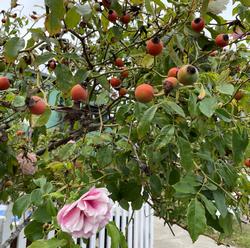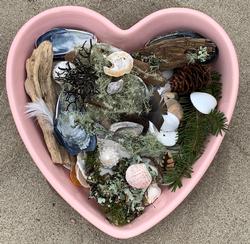Winter fun in Marin gardens
-
Anne-Marie Walker
-
Winter fun in Marin gardens should begin with feeling the wonder of loving the earth. Just before the rains in late October, I sat at dusk with friends in my garden when an Anna’s hummingbird arrived to sip from a border of blooming sage, rosemary, and roses. This enchanting moment reminded me that when you observe in a garden, and you are rewarded. Here are some fun, simple winter garden activities for all those who love to “Look up. Look down. Look all around” in Marin winter gardens.
 Crabapples are by definition any apple smaller than two inches. Skewer them and dip in caramel. Photo: Anne-Marie Walker
Crabapples are by definition any apple smaller than two inches. Skewer them and dip in caramel. Photo: Anne-Marie WalkerDaisies, parsley, mint, and roses are still blooming in Marin. Harvest a leaf, flower, fruit, stem, and seed from each and play a game comparing plant family characteristics. For example, mints have square stems and fragrance. Daisies have composite flowers with disks and rays. In the rose family, look up into crabapple trees and climbing roses. Harvest their fruits and sample for fun; crabapples are tasty dipped in caramel, and rose hips make a delicious tea. Parsley and herbs can be picked and chopped to mix with butter for herbed popcorn.
If you are growing winter greens, look down and engage in a bug treasure hunt. Inspect the leaves for the larva of leaf mining flies and moths. Check for an ambush bug, a fierce predator that captures prey ten times its size and eats aphids, scale, leafhoppers, and other destructive insects. Remember, it is good practice to “watch but don’t touch!” especially while determining if it is a pollinator, predator, prey, or decomposer. In the soil under your veggies, look down, and you may find a roly-poly (pill bug), a decomposer that breaks down dead leaves. Roly-polys are not insects but rather terrestrial crustaceans that roll defensively into a ball. You may also find ladybugs and spiders, both predators (an insect, and an arachnid, respectively). For fun, sing songs and not just “Ladybug, Ladybug” and the “Itsy Bitsy Spider” but also “Boris the Spider” by The Who. Rose hips make a Vitamin C rich tea. Pour 1 cup of hot water over ¼ cup of hips. Steep 20 minutes. Photo: Anne-Marie Walker
Rose hips make a Vitamin C rich tea. Pour 1 cup of hot water over ¼ cup of hips. Steep 20 minutes. Photo: Anne-Marie WalkerLook all around your garden to better understand the dynamic between plants, soil, and wildlife. Do you see lichens, galls, or cones? My two-year-old granddaughter happily gathered and assembled some in a dish after a garden walk in West Marin. Lichens gather moisture and nutrients from the air and produce acid, which in turn breaks down the rock to form soil. Soil builds up when plants move in, followed by decomposers and other organisms that further break down plant material. You may see squirrels and birds pick apart ripened cones that have fallen to the ground, an important, nutritious source of food to lots of wildlife. Collect and compare the size of cones to their trees; you may be surprised. California’s tallest tree has one of the smallest cones. If you are lucky enough to have an oak tree in your garden, it is fun to watch jays pilfer in granaries made by acorn woodpeckers. By observation, scientists have discovered that woodpeckers prefer large acorns while jays prefer smaller acorns. Both birds stay year-round in Marin, avoiding the dangers faced by animals that have to migrate in search of food habitats.
Having so much fun, you may ask what can be done in winter to make our gardens thrive and support wildlife and the greater ecology. We can let seeds develop in flowers so birds can eat that seed. When all those seeds are eaten, we can plant attractive berry plants, including currant species, viburnum, and hawthorn. We can install a small water feature. We could build a birdhouse to attract bird species; go to the Audubon site for specifics. We can leave small piles of leaves undisturbed, giving cover to resting butterflies like the Mourning Cloak, as well as overwintering eggs and larvae. So venture out this winter into your garden for some fun. Lichens, moss and cones collected in a West Marin garden walk. Photo: David S Walker
Lichens, moss and cones collected in a West Marin garden walk. Photo: David S Walker



